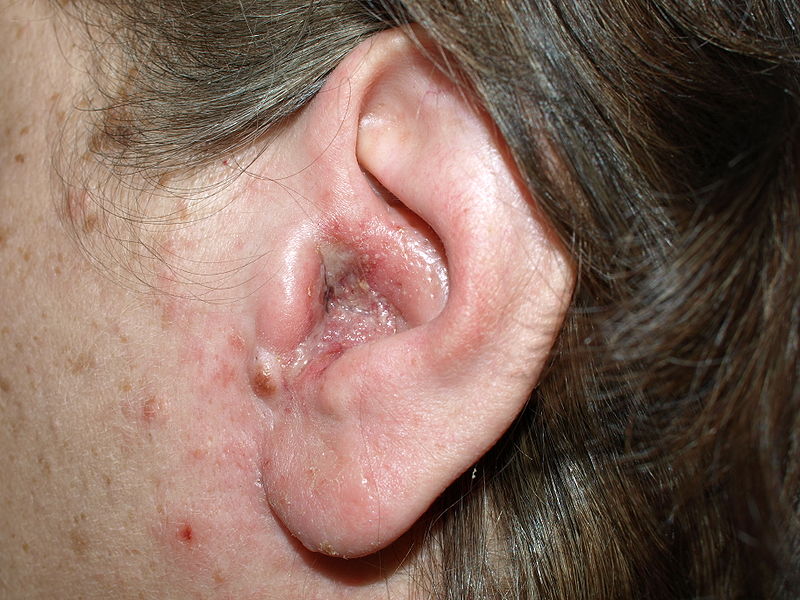Playlist
Show Playlist
Hide Playlist
Otitis Externa (Swimmer's Ear) and Mastoiditis in Children
-
Slides OtitisMediaExternaMastoiditis Pediatrics.pdf
-
Download Lecture Overview
00:01 For otitis externa, we’re talking now about the ear canal. 00:06 We’re worried about different pathogens and different causes. 00:10 This is classically called swimmer’s ear. 00:13 And it’s from a chronically moist external auditory canal. 00:17 It’s associated with prolonged redness or a foreign body in the ear canal. 00:22 Sometimes kids will put something in there and then forget about it and you can get an infection. 00:26 It’s usually associated with Pseudomonas species. 00:29 But other bacteria are possible such as E. coli or staph aureus. 00:35 So here’s a particularly bad case of otitis externa. 00:38 It should hurt a little bit to wiggle on the outside of the ear because you’re moving that canal. 00:43 And there should be frank purulent drainage or swelling visible directly on otoscopy. 00:50 You don’t need a bulb for this. 00:52 It’s on the ear canal itself. 00:54 So patients typically will have ear pain. 00:57 They’ll have pain with tugging on the outer ear and they there’ll be pus draining from their ear. 01:01 That’s your diagnosis. 01:04 How do we treat it? Topical ciprofloxacin drops are usually the trick. 01:09 They do treat pseudomonas. 01:11 Or you can use polymyxin ear drops which is a bit cheaper. 01:15 If it’s super severe, you can insert a wick into the ear to allow for penetration of the drops into the deeper part of the ear. 01:23 It’s not fun to place a wick and the child is not excited to receive one, but it may help the ear heal up a little bit faster. 01:30 Also, we can provide NSAIDs for pain and irritation. 01:34 So let’s turn now to mastoiditis. 01:37 That’s when ear infections go totally wrong. 01:40 This is basically an infection of the mastoid air cells in the skull behind the ear. 01:46 This usually starts with an acute otitis media or an otitis externa and then it spreads down to those air cells. 01:54 So this is usually caused by otitis media bacteria, although some bacteria are more likely to cause it than others, so the differential of organisms is a little bit different. 02:06 It can be caused by Strep pneumo, by Staph aureus and can also be MRSA and by group A strep and also by Pseudomonas, especially if there’s an otitis externa present. 02:20 So these patients can be fairly sick. 02:23 They may have fever. 02:24 They’re going to have significant ear pain. 02:27 You will notice a proptosis or a pushing forward of the affected ear. 02:32 And they will have palpation and pain to palpation behind their ear. 02:37 So if you press behind a protuberant ear and it hurts, that’s mastoiditis. 02:43 You can get a CT scan like this, which will show a opacification of those air cells in the mastoid area. 02:52 And may also show some bony destruction. 02:55 It’s sort of like an osteomyelitis of this skull as well. 02:59 Patients with mastoiditis, which is a rare complication of otitis media, are often admitted to the hospital for IV antibiotics. 03:08 Usually, we’ll start with something like ampicillin sulbactam unless we suspect a very invasive infection such as MRSA. 03:16 And usually, those look very severe and the patients are exceptionally ill. 03:20 Then we might cover for MRSA with either vancomycin or clindamycin. 03:24 And if there is an otitis externa associated with it, we might cover for pseudomonas with something like ciprofloxacin. 03:33 If there is an otitis media with it, oftentimes ear, nose and throat doctors will prefer to do myringotomy in addition to a surgical drainage of the lesion if surgical drainage is necessary. 03:44 And in those surgical cases as deemed by the ear, nose, and throat doctor, we will usually do either a mastoidectomy or a drain placement. 03:52 They may get an osteitis and then we have to have drainage of the bone in addition. 03:58 And we usually will go to surgery if there’s a case that’s not responding to IV antibiotics, likely we might suspect. 04:07 So that’s my review of all ear infections in kids. 04:11 Hey, thanks for your time.
About the Lecture
The lecture Otitis Externa (Swimmer's Ear) and Mastoiditis in Children by Brian Alverson, MD is from the course Pediatric Emergency Medicine. It contains the following chapters:
- Otitis Externa
- Mastoiditis
Included Quiz Questions
Exposure to which of the following is a common cause of otitis externa?
- Swimming pools
- Dogs
- Cats
- Cigarette smoke
- Cold weather
Which of the following is the most appropriate therapy for a 7-year-old boy with a clinical diagnosis of acute otitis externa?
- Topical ciprofloxacin drops
- Topical erythromycin
- Prednisone
- Ibuprofen
- High-dose amoxicillin
A child presents with fever, pain and tenderness behind the ear auricle and auricular proptosis. He has a recent history of otitis media. A CT scan shows opacification of mastoid air cells on the ipsilateral side. Which of the following organisms is the most likely cause?
- Streptococcus pneumonia
- Escherichia coli
- Haemophilus influenzae
- Chlamydia
- Herpes simplex virus
A child presents with fever, pain and tenderness behind the ear auricle and auricular proptosis. He has a recent history of otitis media. A CT scan shows opacification of mastoid air cells on the ipsilateral side. Which of the following is the most appropriate type of management?
- Antibiotic therapy and surgical drainage
- Antibiotic therapy only
- Surgical drainage only
- Watchful waiting
- Antibiotic therapy and topical steroids
Customer reviews
5,0 of 5 stars
| 5 Stars |
|
1 |
| 4 Stars |
|
0 |
| 3 Stars |
|
0 |
| 2 Stars |
|
0 |
| 1 Star |
|
0 |
Covered well very important urgent/ER issues and specially their treatments. Very useful in practice, thank you!!!




